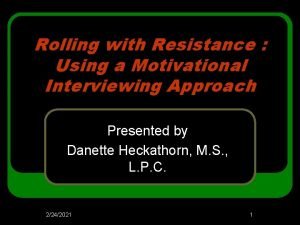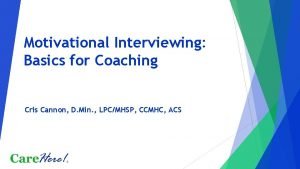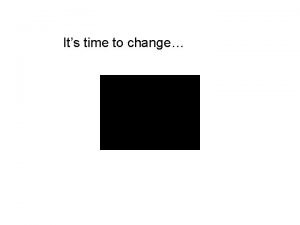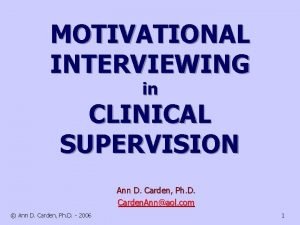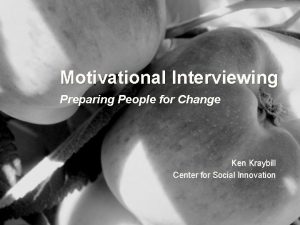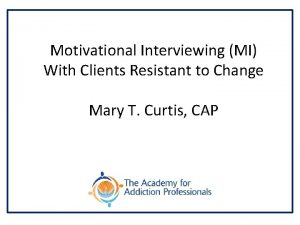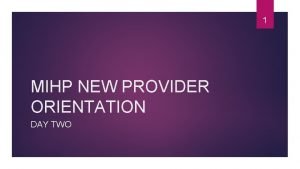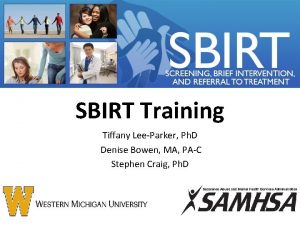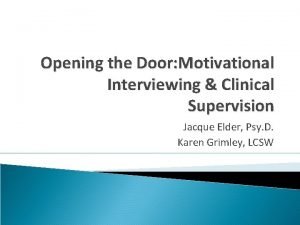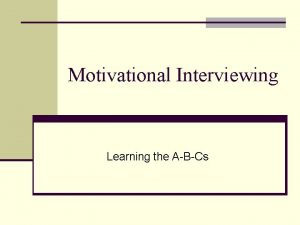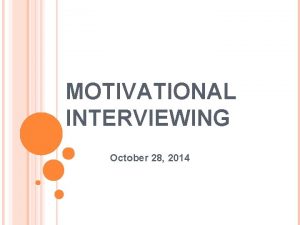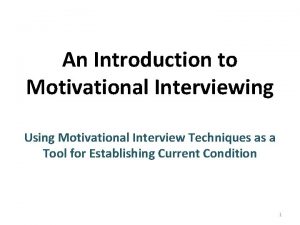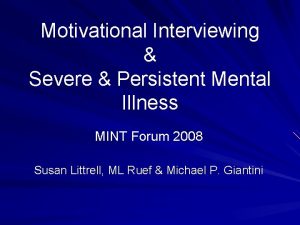Motivational Interviewing in Mental Health Treatment Michael P

























- Slides: 25

Motivational Interviewing in Mental Health Treatment Michael P. Giantini, Ph. D, MA, LPC, MINT Training & Consultation Specialist UMDNJ-UBHC-BRTI-Technical Assistance Center Ph: 732 -235 -9286. E-mail: giantimp@umdnj. edu

Issues in the mental health system n n Persons suffering from severe and persistent mental illness MI associated with at least four EBP’s: IDDT, IMR, SE and ACT MI as an EBP muted by complex set of core principles associated with these EBPs MI vs MH EBP fidelity – Individual clinician vs programmatic – Valuation of fidelity anchor points: n n MI – yes, as much as discernable MH EBPs – not at this time

Issues in the mental health system Wide variations in substance use approaches and philosophy n Multiple co-occurring serious illnesses, especially: n – Mental health – Substance use – Chronic & acute medical conditions – Cognitive impairment – Active MH & SU symptoms

Issues in the mental health system Less overall knowledge regarding substance use issues and the higher vulnerability those with SPMI have to substances in general n History of a strong medical model n Treatment system funded to address acute versus chronic illness (~65% of budget IP care & 24 hour services n

MI & mental health wellness & recovery: the good, the bad & the ugly n n n MI good – client centered, respectful, fits with core wellness and recovery values and philosophy MI bad – use pay off matrix cons as ammunition to establish substance use as no good MI ugly – a manipulative technique clinicians use to get the client to carry out the clinician’s goals/treatment plan

Implementation: NIRN n n n Consideration for the specific evidence based intervention(s) The implementation process & strategies to put the intervention in place Effective intervention practices + Effective implementation practices = Good outcomes for consumers No other combination of factors reliably produces desired outcomes of consumers

An effective implementation strategy 1. 2. 3. 4. Active & qualified Purveyor Systemic use of Implementation Drivers Vertical integration to create aligned systems Attention to Stages of Implementation

1. Active & qualified Purveyor n n An individual or group representing a program or practice who actively work to help others implement that practice or program with fidelity & good effect Accumulates data & experiential knowledge, more effective & efficient over time – Supervisors – can become purveyors over time, but it is difficult to develop & maintain that role

Active & qualified Purveyor n Purveyor interface: – Practitioners – Organization: n Management (leadership, policy, QI) n Administration (HR, structure) n Supervision (nature, content) – System of care – State policies

2. Systemic use of Implementation Drivers are mechanisms that help to develop, improve and sustain practitioners’ ability to implement an intervention or innovation for consumer benefit n They move programs closer to ideal practice n

Implementation Drivers Decision Support Data Systems Staff/Program Performance Evaluation Consultation & Coaching Facilitative Administrative Supports Systems Interventions Recruitment & Selection Pre-service Training

Why focus on practitioner behavior? n The Practitioner is the intervention – Doing the right thing for the right reason at the right time with the right person to maximize progress – Wide ranging inputs (practitioner history & current realities) – Challenge & promise of EBP’s – Be effective consistently

Learning Outcomes of new classroom skills Training Components Knowledge Skill Use in Demonstration Classroom Theory & Discussion 10% 5% 0% … + Demonstration in training 30% 20% 0% … + Practice & feedback 60% in training 60% 5% … + Coaching in the classroom 95% 95%

Learning Dissemination of information by itself does not lead to successful implementation n Training alone, no matter how well done, does not lead to successful implementation n

MI Fidelity n Minimum MI fidelity (MITI) – Accurate empathy – Spirit – MI adherent n Asking permission, affirming, emphasizing personal control, support – MI non-adherent behaviors n Advise, confront, direct – Open ended questions – Complex vs simple reflections

IDDT Fidelity: SAMHSA n n n n Multidisciplinary team Integrated substance abuse specialist Stage wise interventions Client access to comprehensive services Time unlimited services Assertive outreach MI n n n n Substance abuse counseling (CBT) Group DD treatment Fam Psych Ed for COD D & A self help groups Pharmacological interventions Interventions to promote health Secondary interventions for nonresponders

IDDT Fidelity: SAMHSA measures of fidelity are predominantly programmatic vs individual clinician based n Fidelity will include observation of the practitioner and n – Documentation, treatment plans – Supervision and team meetings – Stage of change, MI and CBT approaches

3. Vertical Integration to create aligned systems Will the practice seriously conflict when interfaced with current agency, county, state and federal system? n If so, can the interface conflict be removed or reduced? n

4. Attention to Stages of Implementation Exploration n Installation n Initial implementation n Full implementation n Innovation n Sustainability n 2– 4 years

Purveyor activities during stages of implementation Purveyor Activities (N=577) Implementation Stages Assessment Planning Training Coaching Evaluation Organizational Development System Intervention Explore Install Initial Implementation 97% 1% 2% 20% 32% 48% 3% 31% 66% 8% 6% 86% 3% 23% 73% 11% 16% 73% 37% 30% 33%

Practical considerations n Has your agency: – – – Understood the key principles of the EBP? Weighed the pros/cons of a given practice? Weighed the pros/cons of implementing the practice? Consider the impact of implementing the practice? Discussed its plans in detail with a purveyor – before initiating an action plan? – Discussed implementation with all agency stake holders represented? n n n CEO/President QI Supervisors Staff Consumers Family members

Practical considerations – Considered the stage of change of the staff, supervisors and programs in the agency in relation to the practice under consideration? – Where to begin? – better small and with those interested. Is there a clear plan for implementation? – Does the agency understand all of what implementation involves: training, coaching, ongoing supervision, conflicts with the current internal and external system of care and outcome measures? – What outcomes do you expect from implementation of the evidence based intervention? – How will you monitor that outcome?

References MI: www. motivationalinterview. org/ n National Survey on Drug Use & Health: n http: //oas. samhsa. gov/nhsda. htm#NHSDAinfo n SAMHSA IDDT Toolkit: – http: //www. mentalhealth. samhsa. gov/cmhs/ communitysupport/toolkits/cooccurring/ n ‘Integrated treatment for dual disorders. ’ Mueser et. al. 2003, Guilford Press

References n National Implementation Research Network: http: //nirn. fmhi. usf. edu/aboutus/01_whatisnirn. cfm n TIPS 35 & 42: – www. treatment. org/backup 7 -604/Externals/tips n Co-occurring Center for Excellence: – http: //coce. samhsa. gov/audience/index. html

References n ‘Motivational Interviewing’ 2 nd Edition, Miller & Rollnick, 2002, Guilford Press n ‘Evidence-based Mental Health Practice’, Drake et. al. , 2005, Norton n Ohio Substance Abuse & Mental Health Coordinating Center of Excellence: http: //www. ohiosamiccoe. cwru. edu/about/abo utus. html
 Rolling with resistance motivational interviewing
Rolling with resistance motivational interviewing Contoh motivational interviewing
Contoh motivational interviewing Dears motivational interviewing
Dears motivational interviewing Motivational interviewing schizophrenia
Motivational interviewing schizophrenia Motivational interviewing basics
Motivational interviewing basics Motivational interviewing dears
Motivational interviewing dears Motivational interviewing ears
Motivational interviewing ears Nimi singh
Nimi singh German motivational speech
German motivational speech Motivational interviewing
Motivational interviewing Decisional balance
Decisional balance Double-sided reflection example
Double-sided reflection example Readiness ruler motivational interviewing
Readiness ruler motivational interviewing Motivational interviewing
Motivational interviewing Change talk worksheet
Change talk worksheet Dares motivational interviewing
Dares motivational interviewing Stages of change in social work
Stages of change in social work Darn cat motivational interviewing
Darn cat motivational interviewing Motivational interviewing
Motivational interviewing Agreement with a twist motivational interviewing
Agreement with a twist motivational interviewing Sbirt faith and spirituality
Sbirt faith and spirituality Darn cat motivational interviewing
Darn cat motivational interviewing Motivational interviewing
Motivational interviewing Darn cat motivational interviewing
Darn cat motivational interviewing Change talk worksheet
Change talk worksheet Jeremy wampler
Jeremy wampler
